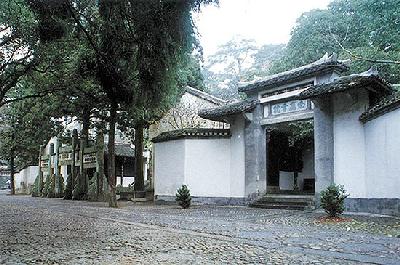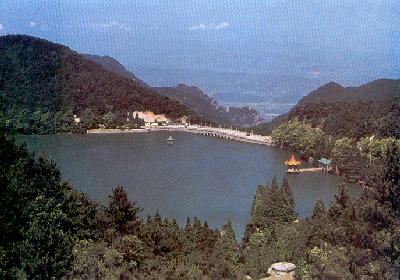Lushan Mountain is located in the northern part of Jiangxi Province, to the south of the Yangtze River and northwest of the Poyang Lake. According to records, it has a history of more than 2,000 years. The scenic area, covering 302 square kilometers, houses 16 natural wonders, 474 scenic spots and 171 peaks, of which the highest peak, the Dahanyang Peak, is 1,474 meters above sea level.
The scenery in Lushan Mountain scenic area is breathtaking. It is full of sheer peaks and precipices, changeable clouds and fogs, silver springs and flying waterfalls. The flora is diverse and comprises about 3,000 species. Features of glaciation during the Quaternary Period make Lushan Mountain even more mysterious. There are millions of migratory birds in the Poyang Lake area. The dancing of the largest number of cranes over the water makes it a world wonder.
 |
| White Deer Cave Academy in Mt. Lushan |
Lushan Mountain abounds in historic and cultural relics. The great historian of the Han Dynasty (206BC-220AD), Sima Qian, once climbed Lushan Mountain, and wrote about it in his classic
The Records of the Great Historian. Bailudong Shuyuan (White Deer Cave Academy) was the most famous of the four biggest academies in ancient China, and enjoys high prestige in the Chinese history of education.
The Donglin Temple (East Grove Temple), built by eminent monks in the Eastern Jin Dynasty, was the birthplace of the Jintu (Pure Earth) Sect of Buddhism. More than 1,500 noted figures in history visited this Mountain, leaving behind some 4,000 pieces of verse and over 900 inscriptions on the cliffs, as well as other writings, prints and calligraphic works. There are about 600 villas here, with the styles of 18 nations and cultures.
 Cultural Heritage
Cultural Heritage
According to legend,Dayu(the Great Yu), who conquered devastating floods in primeval times, visited Lushan Mountain. Qin (221-206BC) Emperor Shihuang also visited the mountain when he toured the south. Poets and scholars of every dynasty were attracted to Lushan Mountain and inspired to compose numerous works. Among them were Tao Qian of the Jin Dynasty (1115-1234), Li Bai and Bai Juyi of the Tang Dynasty (618-907), Su Shi, Zhou Dunyi, Zhu Xi and Li Shizhen of the Song Dynasty (960-1279), and Xu Xiake of the Ming Dynasty (1368-1644).
 Natural Heritage
Natural Heritage
 |
| Ice-klin of Lulin - quaternary glacial remains |
Lushan Mountain features geological structures of every period except the Triassic Period. It has unique evidence of glaciation during the Quaternary Period and is the birthplace of China's glaciological theory.
Though complicated, the geological structure can be clearly traced. Lushan Mountain is a Fault Mountain formed in the Quaternary Period. When it rose, the surrounding land sank, and the Poyang Basin eventually developed into the Poyang Lake. The many grotesque rocks, towering peaks and cascading waterfalls constitute a spectacular Mountain landscape. With frequent fog and mist, Lushan Mountain has cool summers. It also has typical flora and fauna.
 Villas
Villas
 |
| Meilu Villa |
The modern villas are quite a sight on Lushan Mountain. Each villa is an individual building complex with unique style and structure, including styles of Rome- and Gothic- churches, Japanese building and Islamic Mosque. The architects tended to build the villas in shady places, and pursued a natural and casual style. It is this style that enables the villas to be well integrated with the natural scenery. The modern villas on Lushan Mountain, mostly one or two-storeyed, though in clusters, are less densely located and decorated with trees all around, which is a pleasing picture to the eye. The villa complex is simple and natural in style. Each is like a distinctive geometric figure. You could hardly find two villas that resemble each other.
Lushan Mountain was elected to the "World Heritage List" in 1996. Owing to its congenial climate, it is also a popular summer resort in China.
